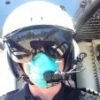Something to watch out for!
So this is my first blog posting. I'm not one for putting my entire life on the web, so I figure I'll use this to post about situations that I've learned from during my flying career. I'm currently an instructor with about 700 hours. This blog entry is a copy&paste of a topic I created in the Flight Training Forum.
So I was finishing up a 3 flight Instrument Proficiency Check yesterday for a guy who has about 700 hours instructing in a Schweizer and only 15 in a R22. It's been a while since he had been flying as he is working outside the industry for the past 6 years, but he's thinking of getting back in.
His instrument flying sucked on the first flight, but yours would too after a 6 year break. We got him back to Instrument check ride standard after only 3 flights which was impressive, and I was prepared to sign off the IPC. At the end of the last flight he mentioned that he wanted to do a few VFR maneuvers. Generally I try to stay away from this kind of thing after an instrument flight, but on this one I obliged.
As we were going around the pattern for the second time, he mentioned that he'd like to do an auto or 2. So we extended the crosswind and downwind while I gave him a briefing on the maneuver. Everything from entry, to being established, to the flare, and finally the power recovery. As we came around on final he set himself up to enter, and I covered the controls. He rolled off the throttle, added right pedal and gentle aft cyclic, all very smooth I might add. The only problem.....He forgot to LOWER the collective!. Or so I thought. I waited for him to lower collective. About a half a second went by and the RPM was passing through 97%, low rotor RPM horn came on and collective was no lower, 90%...collective was no lower. It was at this point that I lowered the collective myself and applied aft cyclic while rolling on the throttle. The lowest point the RPM reached during the maneuver was about 85% or less before they started to come back up. On a warm day that's not were you want to be. Although I've heard horror stories from my friends about the RPM being quite a bit lower, but it still scared the BAJESUS outta me!!
So what was the problem? Why did this guy do what he did? Where did I go wrong with this whole thing? I've come up with my own conclusion, but feel free to add to it, rip me a new one if you think it's needed!
First off, my once hard and fast rule of not practicing VFR maneuvers after 1.3 hours under the hood should have been upheld. People just aren't in the right frame of mind to do autos and the likes after instrument flying. We should have landed, shut down for 30 minutes, and then went up to do them.
Second, during that break on the ground, we would have got a much better briefing done than in the cockpit. The guy said to me afterwards, that in the Schweizer if you enter an auto like in a robbie, by lowering collective before rolling off the throttle, or even lowering and rolling off simultaneously, you risk an overspeed. His plan was to roll off the throttle, wait a second and then lower collective. But even after that second had passed and we were saying "bye bye" to 90% he still wasn't lowering. Maybe he was startled by the horn coming on so soon compared to the Schweizer. With a break on the ground with a full briefing we would have covered the entry more than once and he would have been in a better frame of mind as to what to do in the R22.
It would also have been a good idea for me to demo an auto for him, but I didn't think this was needed as he had around the same amount of flight time as myself.
Lastly, one of the larger errors I made was not to address the differences between the 2 aircraft. I would like to think that I would have covered that to some degree had we briefed on the ground prior to the maneuver.
There was nobody more at fault during this incident than me, the instructor who failed to properly brief the maneuver. I figure I'll write about this here as this business is a learn as you go kinda business, so better others learn the easy way instead of the hard.













3 Comments
Recommended Comments